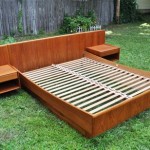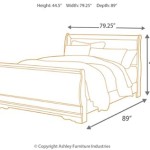How To Fit A Bed In A Small Room
Fitting a bed comfortably in a small room can be a significant challenge. However, with careful planning and strategic furniture choices, it is possible to maximize space and create a restful sleeping area without feeling cramped.
The first step involves careful measurement. Accurate dimensions of the room, including ceiling height, are crucial. This data informs furniture choices and placement options. Equally important are the dimensions of the intended bed. Knowing the exact length and width allows individuals to determine the best fit within the available space.
Choosing the right bed size is paramount. In smaller rooms, a twin or full-size bed is often the most practical option. These smaller footprints maximize floor space while still providing a comfortable sleeping surface. Consider a loft bed to free up valuable floor space underneath. This area can be utilized as a study area, a small seating area, or storage.
Consider the shape of the room and how it impacts the bed's placement. In a rectangular room, positioning the bed against the longest wall is typically the most space-efficient approach. This maximizes the remaining floor area for other furniture or movement. If the room has alcoves or recesses, these areas can be ideal for placing the bed, creating a cozy and secluded sleeping nook.
Multifunctional furniture is a lifesaver in small spaces. A bed with built-in storage drawers underneath eliminates the need for a separate dresser or chest of drawers, saving considerable space. Alternatively, a captain's bed, which features drawers built into the base, offers a similar storage solution. Consider a daybed which doubles as a sofa, providing seating during the day and a comfortable bed at night.
Vertical space is often overlooked in small rooms. Tall bookshelves and wall-mounted storage units provide ample storage without consuming precious floor space. Shelves above the bed can be used for books, decorative items, or storage baskets. Wall-mounted lighting fixtures free up valuable surface space on nightstands.
Minimizing clutter is essential in a small room. Regularly decluttering and keeping surfaces clear creates a sense of openness and spaciousness. Utilizing storage solutions like under-bed storage containers or wall-mounted organizers helps keep belongings organized and out of sight. This maximizes visual space and makes the room appear larger.
Strategic use of color and light can also make a significant difference. Lighter wall colors reflect more light, making the room feel brighter and more spacious. Mirrors can create the illusion of more space by reflecting light and visually expanding the room. Keeping window treatments minimal allows natural light to flood the room, enhancing the sense of openness.
Furniture placement plays a crucial role in maximizing space. Avoid overcrowding the room with unnecessary furniture. Choose smaller-scale pieces that are proportionate to the room’s size. Keep pathways clear to allow easy movement around the room. This contributes to a sense of flow and prevents the space from feeling cramped.
Consider the room's layout and how the bed interacts with other furniture pieces. If possible, position the bed away from the door to create a more private and secluded sleeping area. Leave sufficient space between the bed and other furniture to allow comfortable movement within the room. Creating a floor plan beforehand can help visualize the layout and ensure optimal furniture placement.
Utilizing wall space effectively can create a sense of spaciousness. Hanging artwork or decorative mirrors strategically can draw the eye upwards, making the ceilings appear higher. Avoid placing bulky furniture against the walls, as this can make the room feel smaller. Opt for wall-mounted shelves or floating nightstands to free up floor space.
The choice of bedding can also impact the perception of space. Opt for lighter-colored bedding and avoid heavy patterns or textures, which can make the room feel smaller. Choose simple, streamlined bedding designs to maintain a clean and uncluttered look. Maintaining a tidy and organized space is essential in maximizing the small room's perceived size.
Creating a focal point in the room can draw the eye away from the limited space. This can be achieved through a striking piece of artwork, a decorative mirror, or a unique lighting fixture. Positioning the focal point opposite the bed can create a visually appealing and balanced space.
Careful consideration of these factors can help individuals optimize their small bedroom space for both comfort and functionality. By choosing the right bed size, utilizing multifunctional furniture, maximizing vertical space, and employing strategic design techniques, it is possible to create a restful and inviting bedroom even in a limited area.

Clever Ways To Fit A Bed Into Small Space

6 Brilliant Ways To Fit A Bed Into Small Space

11 Ways To Make A Tiny Bedroom Feel Huge Huffpost Life

11 Ways To Make A Tiny Bedroom Feel Huge Huffpost Life

How To Decorate A Small Bedroom Saatva

20 Smart Ideas How To Make Small Bedroom Look Bigger

3 Furniture Layouts For A Small Bedroom Bless Er House

13 Amazing Examples Of Beds Designed For Small Rooms

Expert Advice How To Make A Small Bedroom Look Bigger

10 Tips To Make A Small Bedroom Look Great
Related Posts







